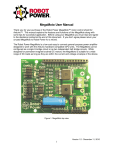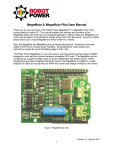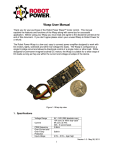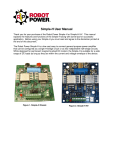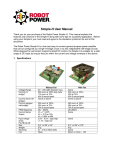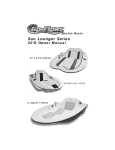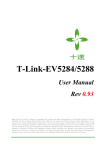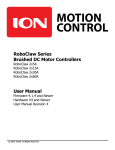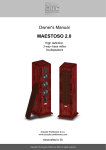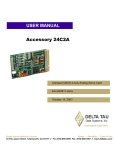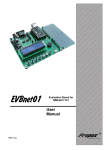Download User`s Manual(current)
Transcript
MegaMoto User Manual Thank you for purchasing the Robot Power MegaMoto™ motor control shield for Arduino™. This manual explains the features and functions of the MegaMoto along with some tips for successful application. Before using your MegaMoto you must read and agree to the disclaimer printed at the end of this document. If you don’t agree please return your unused MegaMoto to Robot Power for a refund. The Robot Power MegaMoto is a low-cost flexible general-purpose power amplifier designed to work with the Arduino hardware compatible CPU units. The MegaMoto can be configured as a single H-bridge circuit or as two independent half-bridge circuits. Designed for permanent magnet brushed DC motors; the MegaMoto is suitable for a wide range of DC loads as long as they are within the current and voltage envelope of the device. Figure 1. MegaMoto top view Version 1.5 - December 11, 2010 1 1. Specifications Voltage Range Current (H1 bridge) Current (each halfbridge) Current (ganged half-bridge) PWM frequency Current Sense Output Digital input voltage levels Power Device Size Mounting 1. 6V – 24V (28V absolute max) 13A cont. at 100% duty cycle 12A cont. at 70% 30A - 5 second peak Same as above Double above DC – 20kHz Vc = I * 0.075 Vc = .0.75 at 10A Vc = 2.99V at 40A 2.5V – 5.5V = logic high <1.7V = logic low 2 ea. Infineon BTN7960B 2.1” x 2.9” x 0.5” 3x - 4-40 or M2.5 bolts. Hole pattern matches Arduino Uno or Duemilanove Your actual current capacity will vary based on the type of load, the length and size of wires, power supply capability and other factors. 2. Features The MegaMoto uses the Infineon BTN7960B as its power-switching element. This chip contains two low-resistance complimentary MOSFET transistors along with protection and driver circuits. Each BTN7960B contains a complete half-bridge and all needed driver circuits including robust protection features. The device features self-protection from over temperature, over current and over and under voltage conditions. As mentioned above the two half-bridge chips may be connected either as an H-bridge or as two independent halfbridges. This flexibility makes the MegaMoto suitable for driving a wide variety of DC loads. The MegaMoto features a current sense output from each half-bridge power chip. This output is a voltage proportional to the current flowing through the high-side transistor within the chip. The voltage output is approximately 0.075V per Ampere of current. When jumpered for individual current readings the A-side and B-side outputs reflect the current passing through the MA and MB motor terminals respectively. When jumpered for combined current output the single voltage output reflects the current flowing through both power chips. So in an H-bridge configuration only the power chip passing current in the positive direction (high-side switch on) will present an output; the other chip presents no voltage output. So in combined current mode the current output is correctly proportional to the current passing through the H-bridge. Version 1.5 - December 11, 2010 2 3. Input Output connections and Jumper Settings Figure 2. MegaMoto connections and jumpers LED Indicators The MegaMoto has three LEDs used for visual indication of the state of the unit. The Enable LED is red and when lit shows that the power chips are enabled. The green PWMA/B LEDs show the presence of an input signal to the power chips. The brightness of the PWMA/B LEDs will vary with the duty cycle of the input signal. Note, these LEDs reflect the state of the inputs to the power chips not the actual output voltage. It is possible for the power chip to be in safety shutdown while receiving an input signal. Thus it is possible for the LED to be lit but there to be no voltage is output from the power chips. It is possible and often prudent to code and debug the Arduino application with no battery or motor connected to the MegaMoto but rather using the LEDs as visual indicators. The LEDs are powered by the Arduino outputs and do not require a battery connected to the MegaMoto. Jumper Connections The MegaMoto uses jumpers to select which Arduino pins are used for all functions. This allows several independently controlled MegaMoto units to be stacked on one Arduino base. The MegaMoto also cooperates well with other shields that might have hard-wired pin assignments. Version 1.5 - December 11, 2010 3 Enable Jumper: This jumper selects the Arduino pin used to enable and disable the MegaMoto under program control. There are four choices on this jumper block. One and only one jumper must be placed on this block to choose the enable source. Logic HIGH enables the unit. Do not attempt to drive the MegaMoto by pulsing the Enable input. This method of driving does not work with these power chips. Enable Jumper Connections D13, D12, D8 5V Enable using one of these digital pins – set HIGH to enable The MegaMoto is always enabled (see usage notes) PWM A/B Source Jumper: The MegaMoto is designed to use the PWM outputs from the CPU timer peripherals. Placing a jumper onto these pin header blocks connects the input of the power chip to the output of a CPU timer pin. The standard Arduino CPU is the ATMega328. This chip has three hardware timers which control several digital output pins using the AnalogWrite() library function. One and only one jumper must be placed on each PWM source block to connect the power chip inputs to a CPU output. The MegaMoto does not function with a PWM and Direction input. Note, the standard PWM frequency (~500hz) provided by the AnalogWrite() function may be too low for many motors or other loads. The CPU registers dedicated to the timer peripherals can be modified to increase the PWM frequency. See the CPU datasheet for details on controlling the timer peripherals. Base units other than the standard ATMega328-based Arduinos may have more timer outputs not located on the standard pins. The output of these timers may be connected to the MegaMoto power chips by using wire jumpers. While this method is not as clean as the PCB internal connections, the MegaMoto still provides support for non-standard Arduino variants. PWM Source Jumper Connections PWMA D6 D9 D11 PWMB D5 D10 D3 A-side power chip PWMA from pin D6 – Timer0 PWM0A PWMA from pin D5 – Timer1 PWM1A PWMA from pin D11 – Timer2 PWM2A B-side power chip PWMB from pin D5 – Timer0 PWM0B PWMB from pin D10 – Timer1 PWM1B PWMB from pin D3 – Timer2 PWM2B Current Sense Jumpers: The Infineon BTN7960B power chips used in the MegaMoto provide a current mirror output that reflects the current passing through the high side of the half-bridge inside each chip. This current is passed through a 634Ω resistor to provide a voltage that can be read by the Arduino CPU. Since the low side of the half-bridge provides no output on the current sensor pin, it is possible to connect the sensor outputs from both power chips in parallel. When the MegaMoto is configured as an H-bridge the current sense output of the connected sensor outputs properly reflects the current through the bridge in either direction. A close up of the SENSOR jumper block is shown in Figure 3. Version 1.5 - December 11, 2010 4 Figure 3. Current sensor jumper block When operating in H-bridge mode, the jumper shown in red above may be placed on the header to link the current sense outputs of both chips. A second jumper chooses which Arduino analog pin to connect to this combined signal. To monitor the individual half-bridge current outputs, do not place the jumper shown above. Two jumpers are used to connect each power chip’s current sense output to a different analog input pin. See the application examples section for more details. The current sense output is optional and need not be connected if load current monitoring is not desired. Power Connections Motor Outputs: The MegaMoto circuit is two independent half-bridge circuits mounted on a single PCB. The MA output is controlled by the PWMA input and the MB output is controlled by the PWMB input. The screw terminal and the solder pads on each side are tied together and either or both may be used to power the load. Battery Inputs: The MegaMoto requires an external battery connected to the BAT + and – inputs. This battery is not connected to the Arduino supply and cannot be used to power the Arduino through the MegaMoto. There is no voltage regulator on the MegaMoto. The MegaMoto does not require external filtering or voltage regulation. It may be used directly with a 6V-28V battery or other voltage source. Connections can be made using either the screw terminal or solder pads or both. 4. Application Configurations When connected, as an H-bridge the MegaMoto is suitable for driving DC brushed motors both forward and reverse with variable speed. It may also be used to drive other bi-directional loads such as Peltier junctions, electromagnets and other DC loads. Pulse-width modulation may be applied to the inputs of the MegaMoto to vary the average voltage applied to the load. Thus the MegaMoto supports both variable speed and direction of a single load. Since the MegaMoto supports 100% ON and OFF signals for the inputs, you may use binary signals to activate the power chips if variable speed is not needed. When connected in half-bridge mode the MegaMoto may be used for driving uni-directional loads such as lamps, heaters, solenoids or DC motors in one direction. The true half-bridge configuration of the power MOSFETs in the BTN7960B allows for efficient driving of loads with variable speed. Both half-bridges may operate independently or they can be ganged together in parallel to support approximately double the current of the H-bridge or single half-bridge configuration. Version 1.5 - December 11, 2010 5 When driving DC motors it is important to understand the power switch configuration within the BTN7960B chip. As long as the enable line is held logic high, the motor terminals (MA and MB) are connected either to the BAT + or BAT - terminal through their respective power device. In an H-bridge configuration when both PWMA and PWMB are at the same logic level the load will be shorted through the power chip MOSFET switches and one battery rail. This provides a strong “braking” action to the motor. To turn off all power switches the Enable line must be pulled low. This is a freewheeling “coast” condition for the load. Following are some common configurations: H-bridge Mode Example Figure 4. MegaMoto H-bridge mode Function Enable PWMA PWMB Current Sense Jumper D8 D11 D3 A0 Bridged Notes D8 is used to enable the H-bridge Timer2 PWM2A Timer2 PWM2B Both halves of the h-bridge report current on A0 H-Bridge mode is the most common configuration used for driving DC motors. It allows each MegaMoto to drive one DC motor in forward and reverse with variable speed. Each Arduino Uno type base unit can support up to three stacked MegaMotos and hence three independently controlled motors. Extended function Arduino units, such as the Arduino Mega, with more than six timer outputs may use wire jumpers to connect to the PWMA/B inputs and drive more than three stacked MegaMotos or use different timers than the standard Arduino. Version 1.5 - December 11, 2010 6 Dual Half-bridge Mode Example Figure 5. MegaMoto half-bridge mode Function Enable PWMA PWMB Current Sense Jumper 5V D6 D10 MA – A3 MB – A0 Notes Both power chips are always enabled and cannot be disabled via program control when the jumper is in this position Timer0 PWM0A Timer1 PWM1B Each half-bridge is reported on a different analog pin Half-bridge mode is used for uni-directional loads such as fan motors, pumps, lights, solenoids and other loads that don’t need to reverse direction. A single MegaMoto may control two motors independently in this mode. Also, a brushless motor may be controlled using two MegaMotos to provide three half-bridge circuits. Three MegaMoto units can supply six halfbridges so two brushless motors may be controlled by a full stack of three MegaMotos on a single Arduino base. Version 1.5 - December 11, 2010 7 Ganged Half-bridge Mode Example Figure 6. MegaMoto ganged half-bridge mode Function Enable PWMA PWMB Jumper D13 D11 Jumper to D11 Current Sense A1 Notes Pin D13 is used to enable the MegaMoto Timer2 PWM2A Both the A-side and B-side chips must be driven from the same signal source or else there will be a momentary short from chip to chip when they switch at slightly different times. Current monitoring is done on only the Bside chip. So the current read is ½ of the total current. Either A or B-side current can be monitored. Ganged half-bridge mode is used for a larger uni-directional load. This mode is slightly tricky to use because the power section of the power chips are joined together. If the chips switch at different times there will be a short condition from chip to chip potentially destroying them. Thus, a single PWM source must be used for both chips. This cannot be done with jumper plugs but must be done with wire jumpers from between the PWM selection headers as shown in Figure 6 above. It is possible to used three stacked MegaMoto units in ganged halfbridge mode to drive a large brushless motor as each ganged MegaMoto acts like a single half-bridge circuit. 5. Additional notes on driving the MegaMoto A number of aspects of the MegaMoto circuit are important but may not be obvious to the new user. Enable: The unit must have a logic high signal on the enable input to allow the power chips to function. Unlike some of the other power drive chips available, the Enable input cannot be Version 1.5 - December 11, 2010 8 pulsed with a PWM signal. The various internal protection circuits require a steady Enable state to function properly. The MegaMoto provides an option for the Enable signal as 5V connected to the input via the a jumper. However, in that case the unit cannot be disabled. Further if the unit ever goes into thermal or over-current shutdown the Enable input cannot be used to reset the chip and the entire Arduino system power must be cycled. Connecting the Enable to 5V is recommended only when the load is very unlikely to encounter an overload or when an overload should never automatically reset i.e. user action is required before resuming operation. When several MegaMoto units are stacked onto an Arduino base it is possible to use a single digital pin to enable/disable all of the MegaMotos. This does not allow individual enable/disable functions but can be used if all the loads (motors) are always enabled or disabled together. For example a kinetic sculpture might use three motors but would never operate just a single motor alone. The Enable input is also used to reset the power chip protection circuits in the case of an over temp or over current shutdown. The power chips are designed such that these faults are latched and the chip will remain off for safety until reset. To reset the power chips after a fault lower the Enable input for at least four microseconds (4 µS) then raise to logic high again. PWM Source: As with the Enable input above, each MegaMoto power chip must have a PWM source connected to function. If no PWM source is connected the power chip will connect its output to the Batt + rail while enabled. This is important to keep in mind during system-reset conditions on the Arduino. When doing program load and other extended reset conditions half-bridge connected motors will run. H-bridge connected motors will not spin because both A-side and B-side outputs will be at the same level. Battery power should be removed during program development. It is not necessary to have battery connected when the system starts up. It may be connected at any time and disconnected at any time without interrupting the Arduino program. The PWM inputs do not have to be pulsed. A steady on-off switch-like action of the output can be achieved if desired. Thus D3, for example, might be used as a simple digital output pin and changing its output level between logic high and logic low will switch the B-side power device either on (connected to Batt +) or off (connected to Batt -). This works fine for lights, fans and solenoids or various full-power or off type loads. This frees the scarce timer resources for other uses. As with the Enable input, it is possible for multiple MegaMotos to use the same PWM source. For example, if two motors always operate together, identical jumpers for Enable and PWMA/B can be installed on two stacked MegaMotos. This obviously saves pins and allows more motors to be controlled from a single Arduino at the expense of individual control. In fact, there is no real limit to the number of MegaMoto units controlled in this way. The three MegaMotos per Arduino limit is only for completely independently controlled loads. If you have five motors that always operate together or in identical groups there is no reason why five or more MegaMoto units cannot be stacked up. This might prove unwieldy from a physical standpoint but electrically it will work. Current Sense: The current sensor outputs are different than the logic-level inputs such as Enable or PWM. These outputs source a current that is converted to a voltage by a resistor. As such they are much more sensitive to being connected in parallel between units or between A-side and B-side power chips. The bridged connection in H-bridge mode works because the current sense output provides zero current when the low-side of the power chip is Version 1.5 - December 11, 2010 9 passing current. In various half-bridge modes or between stacked units, the current sensors should not be connected in parallel. A secondary function of the current sense output is to indicate if the device has gone into protective shutdown. The Arduino can monitor the current sensor voltage to detect safety shutdown. If the current sense output is giving a steady logic high a fault condition is indicated. A short pulse on the Enable pin will reset the protection circuits and allow the device to operate again assuming the fault condition has cleared. Over temperature shutdown may take several seconds to clear as the device cools. In some cases operator attention is required if the device enters shutdown i.e. some serious or dangerous fault is indicated. In that case the power chips will remain latched off until the power chip voltage source is cycled. The Arduino power source does not need to be cycled in that case just the voltage source connected to the power chips. Power connections: The power connections Batt + and Batt – are the primary voltage source for the power chips and hence the motor outputs MA and MB. The power chips are internally powered and no external voltage source is required to power the input or protection circuits. The power chips are not connected to the 5V or 3.3V connections from the Arduino. The exception is the 5V jumper on the Enable block. However, this is simply to provide a logic high to the Enable input pins and no significant current is drawn from the Arduino 5V supply. When multiple MegaMoto units are stacked on one Arduino base it is important that the power connections be closely tied. Since the negative (ground) connections are common between the Arduino and the MegaMoto there is a possibility of a “ground loop” in which the negative rail connections have a slightly different voltage. This is commonly due a very long or thin battery negative wire or to daisy chaining the power rails from one unit to the next in a chain. Since the design of the MegaMoto assumes that the ground connections will be at the same level it is important to avoid ground loops. The best practice to ensure this does not happen is to connect the negative battery connection from each unit directly to the battery negative terminal and not chain the negative connection from unit to unit. However, if the two or more MegaMoto units are stacked on an Arduino it is acceptable to chain from one unit to the next as long as a good connection is made to each unit and the wire is of sufficient size to cause negligible voltage drop at the load current. When in doubt thicker and shorter wires are better. Further if two different voltage sources (batteries or power supplies) are used, say one to power the Arduino and one to power the MegaMoto, it is imperative that the connection between the negative terminals of the voltage source be lower impedance than that between the Arduino and the MegaMoto. This is to prevent a ground loop between the Arduino and MegaMoto, which can destroy either unit. See Figure 7 for an illustration of this. If the Arduino is powered by a USB connection it is not necessary to provide this negative-tonegative connection as the USB ports are protected against such faults. Version 1.5 - December 11, 2010 10 Figure 7. MegaMoto and Arduino connected to different batteries 6. Interaction between the MegaMoto and the Arduino The MegaMoto is designed to provide a flexible interface to the Arduino but still offer some protection against damage to the power chips feeding into the Arduino. In the worst case a catastrophic failure of a power chip could allow the high voltage battery voltage to appear on the input pins. To limit the damage in this case high value resistors are inline with all Arduino output lines. These resistors allow the low-current digital signals to pass but will drop any high voltage present before it can effect the Arduino CPU. The exception is the current sensor feedback analog output. This output from the power chips is not buffered and is a potential, but extremely low probability, failure point. A proto-shield with an op-amp buffer is recommended if maximum robustness is required along with the current feedback from the MegaMoto. 7. Warnings The following warnings should be heeded when using the MegaMoto to avoid failure of the device: 1. Bench type power supplies do not tolerate regenerative current i.e. current flowing back into the power supply. Often their voltage will increase until the extra power is Version 1.5 - December 11, 2010 11 dissipated. If the MegaMoto is operated at 24V with a power supply of this type it is possible to exceed the maximum rating of the device and destroy the power chips. When using a bench supply it is recommended that you operate at a lower voltage Adding a battery in parallel with the output of the bench supply will provide a buffer which can absorb the extra energy and avoid this type of failure. 2. Sensible driving of the load will increase the life of both the electronics and the motor. Do not repeatedly switch instantly from full forward to full reverse. If possible reduce the applied load voltage gradually by reducing the PWM duty cycle over the period of a few milliseconds. This allows the inductive energy in the circuit to dissipate without the inductive voltage “kick” that often occurs on abrupt interruption of the load current. When using a bench supply even switching from full speed to full stop may cause an inductive kick that can damage the device if the operating voltage is close to the upper limit. 3. Monitor the device temperatures. The power chips will protect themselves against overloads but repeated operation until the over temperature or current protection circuits are activated will shorten the life of the device. Add a fan to speed the cooling and increase current capacity. During development and testing the devices should not exceed 100C (painful to the touch) or they may exceed the operating temperature limits during extended use. 4. Attempting regeneration while the battery is fully charged may lead to larger than expected voltage rise at the battery possibly exceeding the maximum for the MegaMoto. Many batteries have significantly increased impedance when fully charged. This can cause a large voltage spike when attempting to flow current into the fully charged battery. Once the battery has discharged somewhat its impedance to reverse current should be much lower and regeneration can safely be used. 5. Disconnecting the battery from the MegaMoto while current is flowing through the load may cause voltage spikes (inductive kick) high enough to damage the MegaMoto. Always ensure the load current is close to zero before disconnecting the battery. Ideally of course nothing should be connected or disconnected unless the entire system is powered off. 6. As mentioned above, when connecting motors in half-bridge mode care must be taken regarding the behavior of the motors when the Arduino is reset. Normally half-bridge connected motors pass current through the high-side of the power chips. This allows the current sensor portion of the power chip to monitor the motor current. However, the low-side (motor lead connected to battery negative) connected motor will run when the Arduino is reset or disconnected because the power chip turns on the high-side power switch if there is no active input signal. Motors connected in H-bridge mode do not run because both motor leads will be connected to battery positive during reset. In applications where positive control of the load at all times is required, a high-side (motor lead connected to battery plus) connected load is recommended. The current sensor function will not work but the motor will not spin if the Arduino is reset or fails. 7. There is often confusion surrounding the term “PWM”. In common usage it can mean either an RC servo command or a 0%-100% duty cycle square wave train. The latter is the proper usage for the MegaMoto. The MegaMoto does not contain a CPU chip and has no way to interpret RC servo commands such as those generated by the servo.write() or servo.writemicroseconds() commands from the standard servo library. The AnalogWrite() command generates the variable duty-cycle waveform that the MegaMoto power chips will respond to. Version 1.5 - December 11, 2010 12 8. Dimensions and Mounting 9. Schematic and code examples The most current version of the MegaMoto schematic may be downloaded from the Robot Power Web site. www.robotpower.com/downloads/ . Code examples, when available, will be posted in the same location. 10. Further questions For questions not answered by this document or for application advice please feel free to contact us. We’ll be happy to answer your questions and hopefully together we can make your Arduino project using the MegaMoto a big success. You can contact us at the following address: Robot Power 31808 8th Ave. S. Roy, WA 98580 USA 253-843-2504 [email protected] Thanks again for purchasing the MegaMoto and best of luck with your projects. The Robot Power Team Version 1.5 - December 11, 2010 13 Disclaimer: The MegaMoto is intended for educational and experimental uses. It should not be used in applications where human life or health or significant property value depend on its proper operation. Robot Power is not responsible for any loss or damage incurred by the operation or failure of this unit. We make no claims as to suitability or fitness for any application or use. The specifications listed for the unit are accurate to the best of our knowledge but are not guaranteed in any way. The buyer assumes all responsibility for proper use, testing, and verification of this unit in any application. Robot Power’s liability is limited to replacement of defective DOA units. By installing and using this unit you are agreeing to these terms. If you do not agree you may return any unused units to Robot Power for a refund. Version 1.5 - December 11, 2010 14














